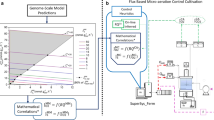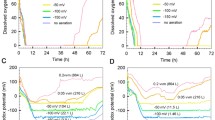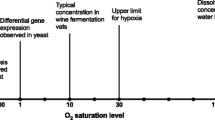Abstract
In order to identify an optimal aeration strategy for intensifying bio-fuel ethanol production in fermentation processes where growth and production have to be managed simultaneously, we quantified the effect of aeration conditions—oxygen limited vs non limited culture (micro-aerobic vs aerobic culture)—on the dynamic behaviour of Saccharomyces cerevisiae cultivated in very high ethanol performance fed-batch cultures. Fermentation parameters and kinetics were established within a range of ethanol concentrations (up to 147 g l−1), which very few studies have addressed. Higher ethanol titres (147 vs 131 g l−1 in 45 h) and average productivity (3.3 vs 2.6 g l−1 h−1) were obtained in cultures without oxygen limitation. Compared to micro-aerobic culture, full aeration led to a 23% increase in the viable cell mass as a result of the concomitant increase in growth rate and yield, with lower ethanol inhibition. The second beneficial effect of aeration was better management of by-product production, with production of glycerol, the main by-product, being strongly reduced from 12 to 4 g l−1. We demonstrate that aeration strategy is as much a determining factor as vitamin feeding (Alfenore et al. 2002) in very high ethanol performance (147 g l−1 in 45 h) in order to achieve a highly competitive dynamic process.




Similar content being viewed by others
References
Alfenore S, Molina-Jouve C, Guillouet SE, Uribelarrea JL, Goma G, Benbadis L (2002) Improving ethanol production and viability of Saccharomyces cerevisiae by a vitamin feeding strategy during fed-batch process. Appl Microbiol Biotechnol 60:67–72
Bayrock DP, Ingledew WM (2001) Application of multistage continuous fermentation for production of fuel alcohol by very-high-gravity fermentation technology. J Ind Microbiol Biotechnol 27:87–93
Costenoble R, Valadi H, Gustafsson L, Niklasson C, Franzen CJ (2000) Microaerobic glycerol formation in Saccharomyces cerevisiae. Yeast 16:1483–1495
Franzen CJ (2003) Metabolic flux analysis in RQ-controlled microaerobic ethanol production by Saccharomyces cerevisiae. Yeast 20:117–132
Furukawa K, Heinzle E, Dunn IJ (1983) Influence of oxygen on growth of Saccharomyces cerevisiae in continuous culture. Biotechnol Bioeng 25:2293–2317
Grosz R, Stephanopoulos G (1990) Physiology, biochemical, and mathematical studies of micro-aerobic continuous ethanol fermentation by Saccharomyces cerevisiae. I: Hysteresis, oscillations, and maximum specific ethanol productivities in chemostat culture. Biotechnol Bioeng 36:1006–1019
Hayashida S, Ohta K (1981) Formation of high concentrations of alcohol by various yeasts. J Inst Brew 87:42–44
Hoppe GK, Hansford GS (1984) The effect of micro-aerobic conditions on continuous ethanol production by Saccharomyces cerevisiae. Biotechnol Lett 6:681–686
Kuriyama H, Kobayashi H (1993) Effects of oxygen supply on yeast growth and metabolism in continuous fermentation. J Ferment Bioeng 75:364–367
Nielsen LK, Smyth GK, Greenfield PF (1991) Hematocymeter cell count distributions: implications of non-Poisson behavior. Biotechnol Prog 7:560–563
Postgate JP (1967) Viable counts and viability. In: Norris JR, Ribbons DW (eds) Methods in microbiology, vol 1. Academic Press, New York, pp 611–628
Ryu DDY, Kim YJ, Kim JH (1984) Effect of air supplement on the performance of continuous ethanol fermentation system. Biotechnol Bioeng 26:12–16
Sweere APJ, Mesters JR, Janse L, Luyben KchAM (1988) Experimental simulation of oxygen profiles and their influence on baker's yeast production: I. One-fermentor system. Biotechnol Bioeng 31:567–578
Thomas KC, Ingledew WM (1992) Production of 21% (v/v) ethanol by fermentation of very high gravity (VHG) wheat mashes. J Ind Microbiol 10:61–68
Thomas KC, Hynes SH, Jones AM, Ingledew WM (1993) production of fuel alcohol from wheat by VHG technology. Appl Biochem Biotechnol 43:211–226
Van Dijken JP, Scheffers WA (1986) Redox balances in the metabolism of sugars by yeast. FEMS Microbiol Rev 32:199–225
Vanrollenghem PA, de Jong-Gubbels P, van Gulik PM, Pronck JT, van Dijken JP, Heijnen S (1996) Validation of a metabolic network for Saccharomyces cerevisiae using mixed substrate studies. Biotechnol Prog 12:434–448
Weusthuis RA, Visser W, Pronk JT, Scheffers WA, Van Dijken JP (1994) Effects of oxygen limitation on sugar metabolism in yeasts: a continuous-culture study of the Klyuver effect. Microbiology 140:703–715
Author information
Authors and Affiliations
Corresponding author
Rights and permissions
About this article
Cite this article
Alfenore, S., Cameleyre, X., Benbadis, L. et al. Aeration strategy: a need for very high ethanol performance in Saccharomyces cerevisiae fed-batch process. Appl Microbiol Biotechnol 63, 537–542 (2004). https://doi.org/10.1007/s00253-003-1393-5
Received:
Revised:
Accepted:
Published:
Issue Date:
DOI: https://doi.org/10.1007/s00253-003-1393-5




